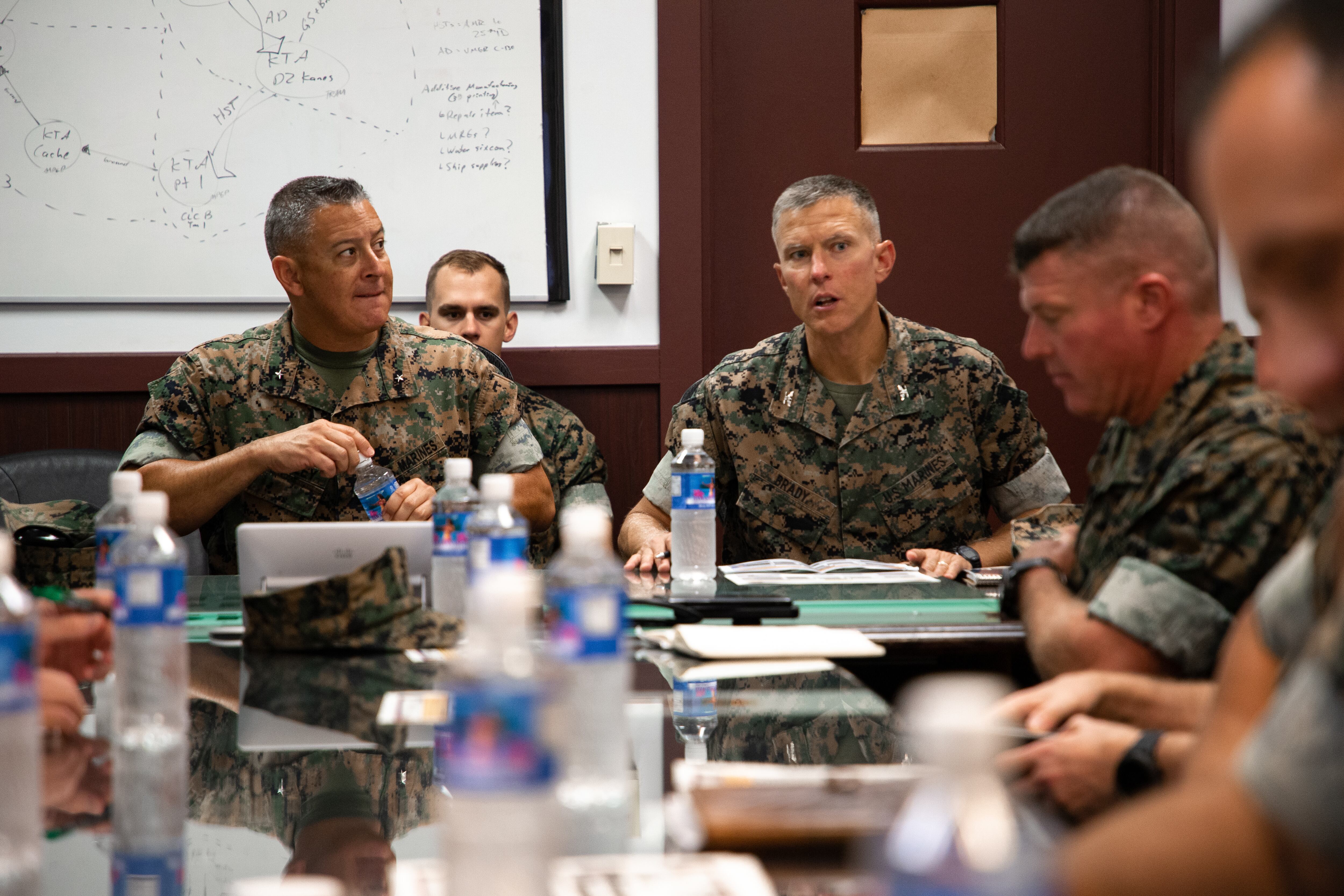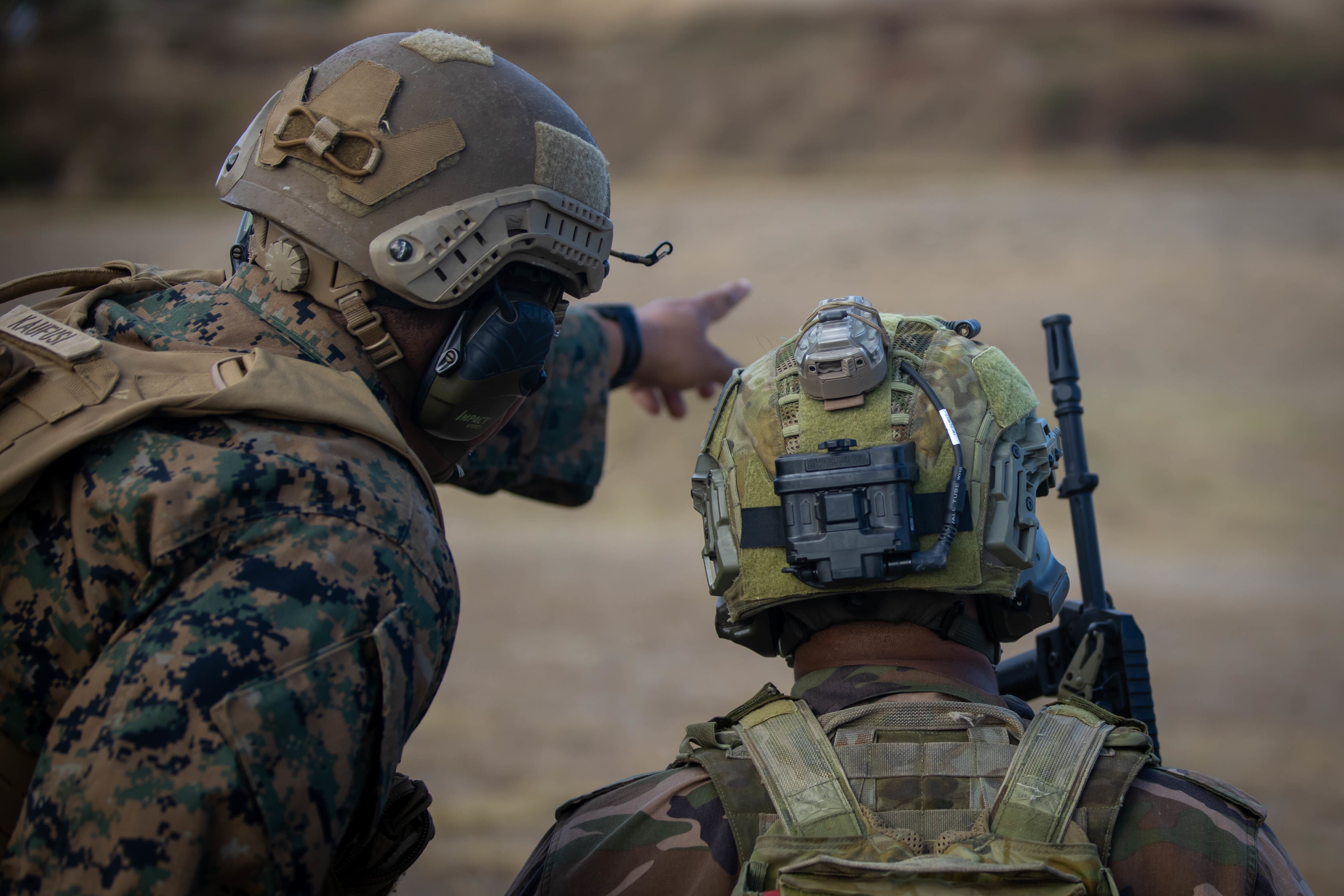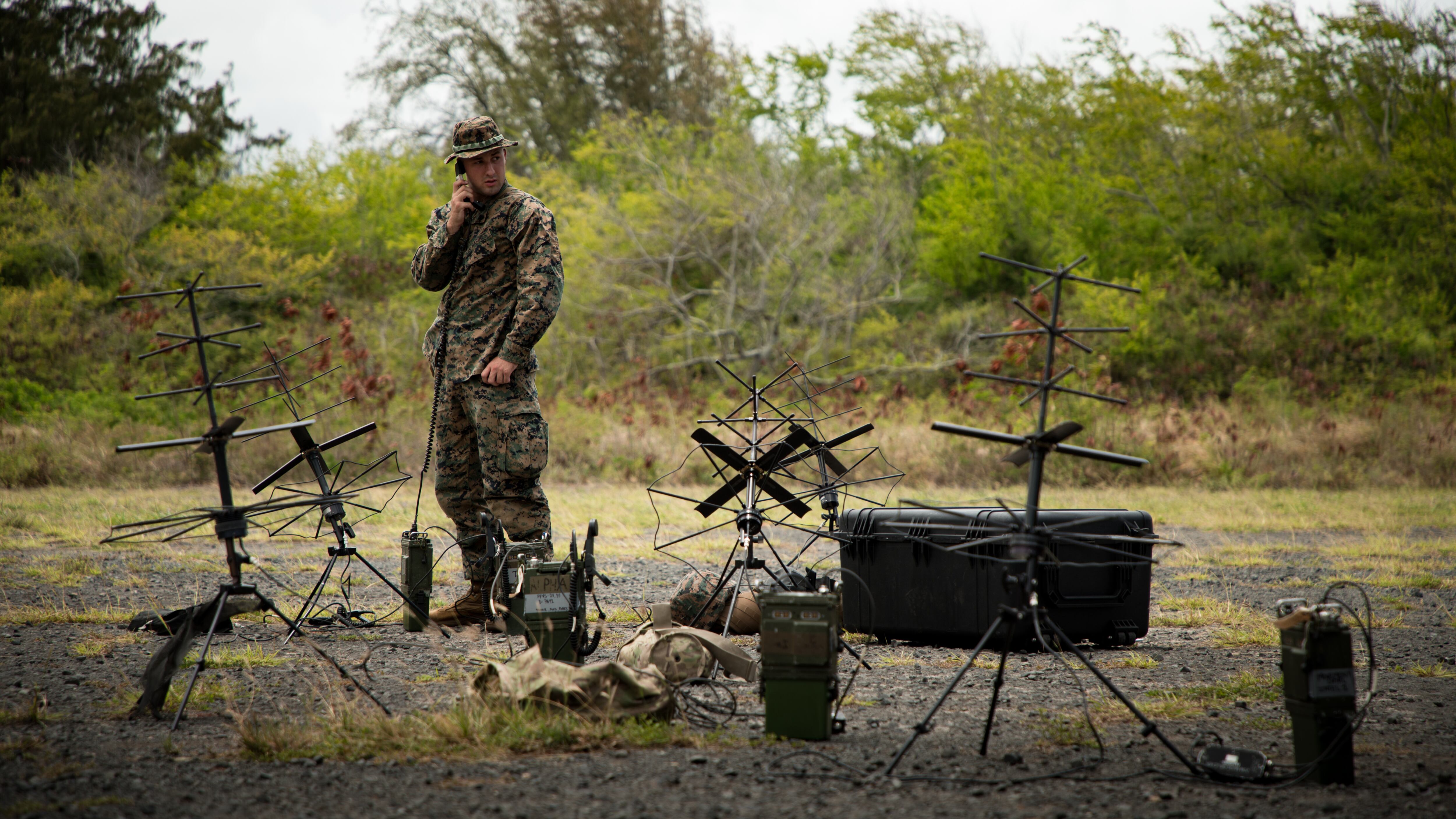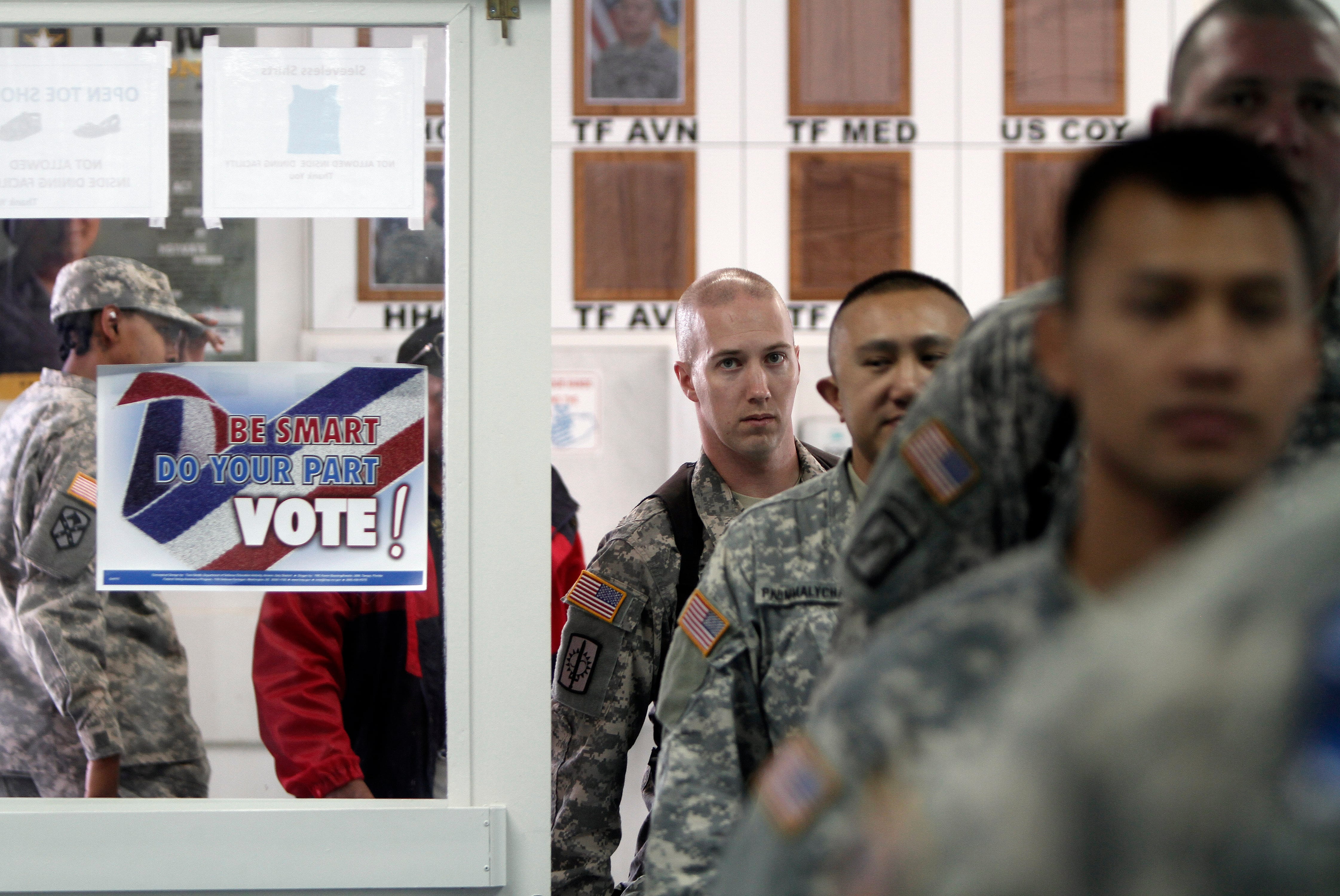MARINE CORPS BASE HAWAII — A new U.S. Marine Corps regiment has shown how it can protect a carrier strike group while navigating through a strait, using only sensors, an unmanned truck armed with anti-ship missiles, and a fires and air detection unit.
The scenario at this summer’s Rim of the Pacific multinational naval exercise allowed the 3rd Marine Littoral Regiment to test its ability to contribute to a future fight at sea — a significant departure from the service’s land warfare focus of the past two decades.
During this test at RIMPAC, the Corps’ newest formation scattered a few task units ashore, who spread out sensors, set up the armed NMESIS truck, and established a fires and air direction element to confirm targets and authorize strikes.
As the carrier strike group approached the strait, it ordered the 3rd MLR to strike an adversary ship attempting to block the waterway. The order and the target came from the ship to the Marines ashore, who “achieved a simulated mission kill on the adversary surface vessel, enhancing the CSG’s [carrier strike group’s] ability to transit the strait unimpeded,” Maj. Oryan Lopes, 3rd MLR’s current operations officer, told Defense News.
“The CSG strait transit was an excellent opportunity to further refine how the 3d Marine Littoral Regiment could support the Combined Maritime Force Component Commander in a future fight. On many levels, the 3d MLR learned how to better communicate within and contribute to maritime operations across multiple task forces,” he added.
A lot of technical work remains before the regiment can declare itself operationally capable: It needs to continue refining the exact number of Marines and pieces of gear it requires, and it needs to reach digital interoperability with the rest of the joint and combined force.
But at RIMPAC 2022, the regiment proved its value thus far to a future maritime fight, in which it would work alongside American partners of the first island chain as a stand-in force in the Pacific. The U.S. Defense Department has previously described that area as “the islands running from the Kurils, through Taiwan, to Borneo, roughly encompassing the Yellow Sea, East China Sea, and South China Sea.” The regiment was designed specifically to operate inside contested areas like the South China Sea, scattering small units around islands and shorelines to conduct missions and then maneuver to a new location before being detected.
RIMPAC ran from June 29 to Aug. 4. An experimentation scheduled for this fall will work out the finer details of how to maneuver and communicate during these distributed operations.

“If you look at standing in, you’re standing in next to a constellation of allies and partners, so we’re vetting how doable this is,” Col. Stephen Fiscus, the assistant chief of staff for force development, said during an interview.
Though “other venues provide the ability to get more exquisite and detailed in how” the new stand-in forces concept will work, he said, RIMPAC proved to be a great first chance to demonstrate “the blocking and tackling level of stuff, to show that you could do this together” in real-world operations.
What is 3rd MLR?
The 3rd Marine Littoral Regiment was redesignated in March to serve as a first-of-its-kind stand-in force in the Pacific. Whereas other traditional formations — Marines operating from U.S. Navy ships, or units on rotational deployments in theater — could fight their way into contested areas, the idea is that 3rd MLR as the stand-in force would already be inside that space. Rather than the joint force having to kick the door down to get in, 3rd MLR could hold the door open, the thinking goes.
Col. Tim Brady, the unit’s commander, said 3rd MLR’s very presence is expected to change the calculus for potential adversaries.
“By standing in, we are deterring the malign behavior. We’re designed to fight and operate inside the enemy’s weapons engagement zone, to conduct and support sea-denial and sea-control operations, and, ultimately, to set the conditions for those joint force follow-on actions. And we’re training and experimenting with all that here at RIMPAC,” he said in the interview.

The key to its success is the range of capabilities brought together under a single Marine colonel, he added.
In February, the Corps activated its 3rd Littoral Anti-Air Battalion. In June, just ahead of RIMPAC, the Marines redesignated 3rd Littoral Combat Team and Combat Logistics Battalion 3. RIMPAC was the first time Brady could operate with these three subordinate commands, which provide the bulk of the capabilities the stand-in force needs: “the lethality of the littoral combat team and what it provides; the air direction, air control, early warning and air surveillance that the littoral anti-air battalion provides; the tactical logistics that the CLB provides,” Brady said.
He called his new unit light, maneuverable and, importantly, tailorable to the mission. “When we actually conduct [expeditionary advanced base operations], we take elements and pieces from each one of those subordinate battalions [and] re-task-organize into different task elements that [can] contribute to the joint and combined force,” he said, noting that he can pull the right amount of people and gear from each subordinate unit based on the mission and expected duration.
For Fiscus, who oversees force modernization for Marine Forces Pacific, the ability to create the right force package for the right mission — and do so quickly — is what makes 3rd MLR interesting.
“I can’t emphasize how novel it was to redesign [the subordinate units], so Tim can now, organic to his formation, task-organize in such a way that you can have that really deep sensing and understanding of the airspace, surface space,” all within a small unit that can either hide or defend itself as needed.
Brady said his regiment would include about 2,000 Marines, though the service’s Force Design 2030 initiative may adjust that slightly as the unit continues to experiment and identify the required capabilities. Force Design 2030 aims to prepare the Marine Corps for a potential future fight with an advanced adversary, such as Russia or China, in line with the National Defense Strategy.
The 3rd MLR is expected to reach initial operational capability by September 2023, and Fiscus called RIMPAC something of a midway point. The unit is mostly done reorganizing and has ideas for how to operate as a stand-in force, but it will still conducting experiments to refine its composition and tactics.
The eyes and ears
Fiscus and Brady agree that 3rd MLR’s greatest contribution to the joint force will be sensing inside an enemy’s weapons engagement zone, which rotational forces might be unable to access without escalating a tense situation or coming under fire.
To be an effective set of eyes and ears on the inside, Brady said Marines’ sensors, communications suites and weapons must be fully integrated with the naval, joint and combined force. Digital interoperability is a primary focus.

During the scenario in which a carrier strike group transited a strait, the 3rd MLR was asked to conduct sea control and sea denial operations from a strategic ground position, making communication between Marines ashore and ships at sea pivotal to mission success.
Maj. Adrian Solis, an action officer on Fiscus’ staff who focuses on fires modernization, said Marines observed how information moved between destroyers and the 3rd MLR, and whether that info went where it was needed or if Marines had to take data from one system and type them into another.
“That’ll be the crux of it: How do we improve our digital interoperability so we take slack out of the kill web, so we execute those kill chains and we’re not wasting time?” Solis said.
The stand-in force’s ability to be in multiple locations, understand the environment and pick out targets will make the force’s kill webs more robust, Brady said, but that kill web must also include sensors and shooters from “our allies and partners who are going to be alongside us inside the first island chain.”
“RIMPAC … really provides us an unprecedented opportunity in that multinational foundation to be able to train and experiment with that digital interoperability — those people, processes and systems — to be able to close kill webs,” he added. “Every time you add a new ally or partner or new aspect of the joint force to that [kill web], there are things that we need to overcome to improve upon the speed and the data transfer of that knowledge and battlespace awareness.”
What comes next?
The next year will be chock-full of milestones and tests for the regiment as it races toward its September 2023 declaration of initial operational capability. Though the regiment will primarily use gear already in the Marine Corps’ inventory, it will begin experimenting with two new items to help with maneuver and resupply: a stern landing vessel in lieu of the eventual Light Amphibious Warship, and a long-range unmanned surface vessel.
Brady said his regiment plans to eventually create a company to operate the unmanned vessel, but in the short term, later this summer, “we do receive 39 Marines as part of the research and development platoon. Most of that experimentation and training will happen back in Norfolk, [Virginia], but those Marines will come to us later on this summer.”
Fiscus pointed to the stern landing vessel as a highlight of the 3rd MLR’s upcoming work, saying the ship would head to Southern California and then make its way out to the regiment in Hawaii.
“That’s a lot of the experimentation of how do we continually maneuver — move, maneuver and sustain … the stand-in force,” he said.

Brady previously said the regiment might use the stern landing vessel to move from Oahu to the big island of Hawaii, then go ashore for operations at the Pohakuloa Training Area. While Marines conduct missions at the range, the vessel might practice maneuvering at sea to stay hidden, or it could retrieve spare parts, ammunition, food and other goods to resupply Marines when they return to the beach.
Later this fall, Brady told Defense News, the Marine Corps will deactivate Bravo Battery, 1st Battalion, 12th Marines and redesignate the unit as Medium Missile Battery under the 3rd Littoral Combat Team, in what the colonel called a major milestone in implementing and shaping the 3rd MLR and its lethality.
After that redesignation — the last major organizational move, other than the eventual long-range unmanned surface vessel company — Brady said he’ll be able to get into the weeds of several outstanding questions.
“What is the size of those task elements, to be able to have a sensing task element and a fires task element? And how many Marines truly is that? What is needed to lift and move those Marines, and what systems are needed to be able to incorporate the kill web for those Marines? Those are the things we’re going to be looking at here this fall,” he explained.
In February, the 3rd MLR will conduct the first-ever service-level training exercise for a Marine littoral regiment, operating around Southern California while testing tactics, techniques and procedures. The unit will then go right into the Balikatan exercise in the Philippines.
Brady said training alongside Philippine counterparts will help the Corps “get after some of the things that they are developing much like our capabilities, in the archipelagic coastal defense concept and the coastal defense regimen.”

Brig. Gen. Joseph Clearfield, the deputy commander of Marine Forces Pacific, told Defense News in a separate interview that the Philippines is one of many key allies and partners in the region that are reshaping their forces in similar ways to the 3rd MLR.
“I spend an awful lot of time in this job interacting with countries on the first island chain to the second island chain; that’s probably one of my primary duties. They are so excited about Force Design [2030], and they all have initiatives underway … to replicate a Marine littoral regiment-like unit,” he said. “They really want to know everything they can about what we’re doing and how we’re doing it.”
In the fall of 2023, Brady said, the larger Marine Forces Pacific’s capstone exercise will demonstrate a range of capabilities — including those of the 3rd MLR — paving the way for a declaration of initial operational capability.
“The MLR is a capability that exists right now today. We are ready and prepared to fight now,” Brady said. “Regardless of all those things we’re going to be continuing to train and experiment with in the future, and the future capabilities that are going to come to the MLR, we’re [a] capable unit today.”
Megan Eckstein is the naval warfare reporter at Defense News. She has covered military news since 2009, with a focus on U.S. Navy and Marine Corps operations, acquisition programs and budgets. She has reported from four geographic fleets and is happiest when she’s filing stories from a ship. Megan is a University of Maryland alumna.




